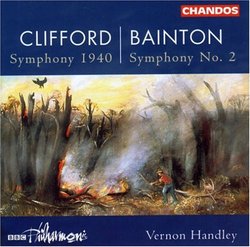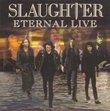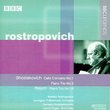| All Artists: Edgar Leslie Bainton, John Gough, Hubert Clifford, Vernon Handley, BBC Philharmonic Brass Title: Hubert Clifford: Symphony 1940; Edgar Bainton: Symphony No. 2 Members Wishing: 0 Total Copies: 0 Label: Chandos Release Date: 10/19/1999 Genre: Classical Style: Symphonies Number of Discs: 1 SwapaCD Credits: 1 UPC: 095115975725 |
Search - Edgar Leslie Bainton, John Gough, Hubert Clifford :: Hubert Clifford: Symphony 1940; Edgar Bainton: Symphony No. 2
 | Edgar Leslie Bainton, John Gough, Hubert Clifford Hubert Clifford: Symphony 1940; Edgar Bainton: Symphony No. 2 Genre: Classical
|
Larger Image |
CD DetailsSimilar CDs
|
CD ReviewsEnterprising and Important. David A. Hollingsworth | Washington, DC USA | 12/19/1999 (5 out of 5 stars) "Add a serving spoon of Sir William Walton and Gustav Holst, a teaspoon of Vaughan Williams, and a couple of pinches of Sir Arnold Bax, Sir Edward Elgar, and Delius, and we therefore get the essence of Edgar Bainton's Symphony no. II in D Minor (1939-1940). The tragic expressionism of Sir Charles Villier Stanford's 4th symphony can also be felt when listening to this work. Bainton's Second Symphony is a one-movement piece (with 12 interlinking, continuous sections) and is rewardingly concise and telling. It's a work mixed with tradegy and seriousness with some sense of optimism. It's a epic piece not far from the Australian heritage Bainton grew up with.Hubert Clifford's four-movement Symphony in D Minor (1938-1940) shares the similar idioms of the 1930s English music. Clifford's work is purly epic and optimistic, a premonition of life and of spring, and is not far from the optimism of Delius and later Malcolm Arnold's earlier symphonies. The Symphony is wholly attractive and compelling, with its thematic ideas distinctive and fresh. The Serenade of John Gough is a nice and memorable filler to this enterprising compact disc.And this disc is enterprising. Vernon Handley and the BBC Philharmonic altogether gave the performances of the works with such a force, emotionalism, passion, and admiration that listening to them makes me want to get up and suggest to various North American orchestras to perform them as well (believe or not, music of Great Britain is not well-represented in North America or even in European countries outside Great Britain or Ireland). As usual, the Chandos recordings provide full, natural, and accurate sound. Well done!May I hope for further recordings and releases of Clifford, Gough, and Bainton's works? Hurry! Get this disc! (even though Chandos is the only recording company that never delete their recordings)." The Pleasure of Discovery Thomas F. Bertonneau | Oswego, NY United States | 10/09/2000 (5 out of 5 stars) "Discovery is one of the delights of collecting musical performances on CD, especially for those of us who either live too far from a major orchestra to be regular concert-goers or who simply lead lives too busy to accommodate the logistics of getting to the concert-hall and back, all in the evening of a distracting day. Not to mention that concert-programs tend to be limited to very mainstream classics and that ticket-prices for the major symphony orchestras have soared. So might one have known Holst's "The Planets" from the concert-hall, but for "Egdon Heath" or the "Choral Symphony" or the "Fugal Overture," one needed recordings - LPs in the old days, now supplanted by the more generous medium of the CD. And sometimes, indeed, it's not merely an unknown work by a composer whom we already know; it's a brand-new (to us) composer, all of whose works at present are a mystery. These remarks furnish the prelude to my strongest recommendation for a recent issue on Chandos: Symphonies by the Australian composers Edgar Bainton (1880-1956) and Hubert Clifford (1904-1959). These two big scores (Bainton's, in D-Minor, from 1939; Clifford's, no key signature, from 1940) belong identifiably to the British school, with recognizable affinities to Vaughan-Williams and Bax. As in Bax, so in Bainton does the orchestration reflect also a knowledge of what Russian and French composers could accomplish in terms of carefully calculated color. As in Vaughan-Williams, so in Clifford do modal harmonies unite with large-scale redeployments of baroque procedures like chorale and passacaglia. Clifford's is the heftiest of the two, clocking in at over forty minutes. Vernon Handley comes naturally into this new-old repertory and leads the gorgeous BBC Philharmonic with aplomb." Postwar Austalian symphonies Larry VanDeSande | Mason, Michigan United States | 02/03/2007 (3 out of 5 stars) "Here's a CD that confuses me -- a 1999 recording of Australian composers no one's ever heard of and music that is in no way individual or magnificent -- that stays in print while other more satisfying recordings depart after a year. This is the same reaction I had when I last reviewed a CD by Australian performers (ASIN: B000003IVO).
This CD puts forth the work of three Aussie composers that were trained in London's Royal Academy of Music -- Edgar Bainton (1880-1956), John Gough (1903-1951) and Hubert Clifford (1904-1959). The symphonies from Bainton and Clifford -- both students of Stanford (Bainton was a friend of Holst and Clifford also studied with Vaughan Williams) reflect common thematic material in England during the period of their compositions and both works show the influence of popular British symphonists. Bainton's Symphony No. 2 in D minor from 1939-40 (but not introduced until after the war) begins the program. Reminiscent in design to Granville Bantock's "Hebridean" symphony, the opus is in 12 disparate parts, a few of which cause the orchestra to stop and restart. The musical language is clearly Elgarian with touches of Britten, Holst and French impressionism entering at various times. Even though the symphony mimics Bantock's "Hebridean", it shares none of its likeness to Richard Strauss. This music is clearly modeled after the Edwardian influence on Elgar and teacher Stanford. Gough's 2-minute "Serenade from small orchestra" is a trilfe hardly worth mentioning. Clifford's "Symphony 1940" from 1938-40 is Waltonesque and a possible tribute to Sibelius, a composer popular in Britian diring the 1930s. The opening Moderato con anima is lightly sprung in major keys, using high brass and strings to promote its happy message. The following Scherzo is more jollity in major keys and the lengthy Adagio that follows (15:43) varies little stylistically or spiritually from the two opening movements. The concluding Allegro molto begins in a quieter, darker cadence but sheds it skin and travels in lively brass figures. It wears much like the opening movements, ending in a explosion of sound. If I sound less enthusiastic than other reviewers here, there's good reason for that. Amazon recommended this CD to me after I bought one of Davis's recent Elgar symphonies. The sound bytes were interesting and I bit. Having digested the contents of this CD, I would say there is not a single thing individual or a single memorable theme herein. Veteran British conductor Vernon Handley and the BBC Philharmonic wring out what there is in these scores. If this represents the state of the symphony from Australia, it's little wonder we know nothing about it." |

 Track Listings (17) - Disc #1
Track Listings (17) - Disc #1


